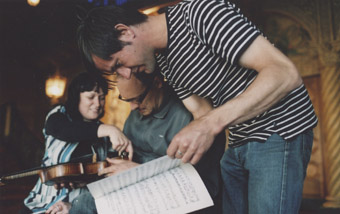whistling on the way to the apocalypse
chris reid catches a flying horse

Dead Horse Productions
DEAD HORSE PRODUCTIONS’ GROUND ELASTIC SOUND IS THE LATEST IN A SERIES OF MUSICAL EVENTS THAT INCLUDES THEIR MEMORABLE CONCAVE CITY OF 2006. DEAD HORSE GOES FOR UNUSUAL VENUES AND THE FABULOUS FORUM CINEMA, DECORATED WITH NEO-CLASSICAL FACADES AND SCULPTURES, CREATES AN EPICALLY MYTHOLOGICAL BACKDROP FOR THIS ENGAGING CONCERT.
The evening is introduced by a cheery voice from an old vinyl record—“Are you ready? Let’s get going!”—and Biddy Connor’s tongue in cheek Ground Elastic Sound Fanfare commences with the clarinet and brass players performing in the theatre’s aisles. The crackly narration (the recording is of whistling) later returns, the fanfare concluding with the performers on stage whistling the fanfare theme—music of the mouth.
Peter Knight’s more cerebral Spirals Part 1, in two contrasting movements for clarinet, trumpet and string quartet, opens with a slow, dramatic cello note. A dialogue between winds and strings develops, sharp gestures overlaying a steady rhythm that builds towards an unfolding melodic line late in the first movement. In the program note, Knight outlines the mathematical basis for the work’s form, a numerical spiral. The short second movement is angular, atonal and gestural. The piece is accompanied by imagery projected on the cinema screen—a slowly evolving abstract form in the first, and latticed sticks in the second, personifying the music.
Light-heartedness returns momentarily with Wally Gunn’s Formwork for tape, which sounds like a theatre organ dubbed over industrial noise and played on a slurring gramophone record. It’s heard while the stage is rearranged for his Eleven Fifty-Five, a strongly coloured work for clarinet, brass, string quartet and contrabass that opens with declamatory gestures from the brass and clarinet. All the musicians are miked for the evening, and the mix for Eleven Fifty-Five foregrounds the brass. The piece develops in motoric passages with a thriller movie feel. The visual imagery is of stylised figures running aimlessly, trapped behind a grid of lines, evoking a struggle between the enclosing industrial world, represented by the overwhelming brass, and humans, represented by tremulous strings. Gunn states in the program his concern that “the world is close to apocalypse”, hence the work’s title.
Kate Neal’s Semaphore, also for winds and strings, is preceded by a video of her own hand writing out the lines of a TS Eliot poem, Chorus VII, from The Rock. Opening with brass layered over glissandi strings, the work is a meditation on semaphore signalling as a form of communication. A vocalist is positioned next to a statue under one of the theatre’s arches. Tristram Williams’ fine trumpet is given scope in this piece, in which the brass again dominates the mix. The work progresses steadily and rather introspectively within a restricted tonal range, and concludes over the projected cartoon of a flag-waving signalman. Biddy Connor’s second work for the evening is Into Hundreds, written in 2000 and performed here to mark the 10th anniversary of her father’s death. Arranged for this performance for clarinet, tenor and baritone saxes and violin, viola and cello, it is a short but eloquent elegy, slow, lyrical and melodic, with combinations of strings and brass producing some delicious moments. Into Hundreds feels like it could be the middle of a three-movement work but is delightful as is.
The final work is David Chisholm’s Ikebana, for live and pre-recorded string quartet (the Silo Quartet). This unusual arrangement must have been technically demanding for the four performers on stage, as the work is in effect an octet and they are cued both through headphones and by a conductor. But the result is impressive. The muted sound of the recording hangs like a ghost over the performers, suggesting a kind of inner dialogue. The solid writing provides a welcome opportunity for leader Miki Tsunoda to showcase her talents. Originally scored to accompany Phillip Adams’s dance work Origami, this vibrant, pulsing work hints at a range of musical forms and flavours, especially mid-20th century. In the absence of the dance, the listener is left wanting more, perhaps a finale movement.
Dead Horse events are a complex blend of innovative composition, performance and visuals, tinged with social observation and curated with an eye to theatrical presentation. At times it can seem contrived but when the blend works, there is magic. There is not quite a house compositional style but, with the exception of Chisholm’s piece, the instrumentation for this concert created a house texture and feel, leaving a memory of solid rhythmic structures, strong instrumental colour and dissonant, edgy lyricism. The longer pieces are 10-12 minutes, absorbing enough but sometimes leaving a feeling of incompleteness. The strength of the Ensemble’s performers shines through.
Ground Elastic Sound, Dead Horse Ensemble, conductor Benjamin Northey, visuals Nina Gonzaga, Robin Fox, Forum Upstairs, Melbourne, February 23
RealTime issue #78 April-May 2007 pg. 40






